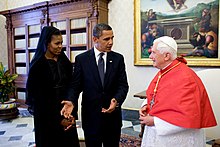Women in Vatican City
| Part of a series on |
| Women in society |
|---|
 |
Women account for approximately 5.5% of the citizenry of Vatican City. According to the Herald Sun in March 2011, there were only 32 females out of 572 citizens issued with Vatican passports. One of them was a nun.[1] In 2013, Worldcrunch reported that there were around 30 women who were citizens of Vatican City, including two South American women, two Poles, and three from Switzerland. The majority of Vatican women at the time were from Italy.[2]
Female residents
Among the women who lived in Vatican City was one of the daughters of an electrician, who later got married and "lost her right to live" in the city. Another woman who lives in Vatican City was Magdalena Wolińska-Riedi, who is a Polish translator and wife of one of the Swiss Guards.[2]
Vatican City citizens
Among the women who have citizenship in Vatican City, there is one officer in the military, two teachers (one teaches in high school, the other teaches in kindergarten), and one academic. Women obtain Vatican City citizenship by marriage (as a baptized Catholic) to their husbands; however such citizenship "lasts only for the duration of their stay" in Vatican City.[2]
Value of women
In the past, women were not allowed to open a bank account in Vatican City, but, during the leadership of Pope John Paul II and Pope Benedict XVI, the value of women in the city was highlighted. One of Pope Benedict XVI's assistant editors and confidential adviser was a woman. Her name is Ingrid Stampa.[2] On April 21, 2013, The Telegraph reported that Pope Francis will be appointing "more women to key Vatican" positions. In May 2019, Francis appointed three women as consultors to the General Secretariat for the Synod of Bishops on Young People, Faith, and Vocational Discernment, marking a historic first for the Church.[3] In addition to this, L'Osservatore Romano - the daily newspaper in Vatican City - is now publishing supplementary pages that address women's issues.[4] Women are not allowed to be ordained to the presbyterate or episcopate, though a commission is currently studying the question of whether women can serve as un-ordained female deacons (deaconesses).
Clothing

Women (and men) visiting St. Peter's Basilica, the Sistine Chapel or the Vatican Museums in Vatican City are expected to wear appropriate attire. Low cut or sleeveless clothing, shorts, miniskirts and hats (for men, indoors) are not allowed. Women may or may not wear the traditional "black hat or veil". Dress code for Papal audiences is somewhat more formal.[5][6] Women cannot wear clothing that does not cover the shoulders and the knees.[2]
Voting rights
Vatican City is the only country in the world with no voting or electoral rights, including no voting rights for women.[7][8] That is because no elections are held in Vatican City, and consequently, neither male nor female citizens or residents have voting rights. Members of the Pontifical Commission for Vatican City State, which forms the legislature of Vatican City, are appointed by the Pope.
The Pope, who serves as the head of state, is elected by the College of Cardinals of the Catholic Church. The College is part of the Holy See, which forms a separate sovereign entity from Vatican City. Cardinals in the Catholic Church are required to be male, with voting Cardinals generally always Bishops, and only men are eligible to be elected Pope. With that being said, however, the cardinalate is a privilege and office bestowed by the Pope; it is not a separate, fourth degree of Holy Orders, along with deacon, priest, and Bishop, though it ranks above them, so theoretically, the laws could be amended to allow for women to be Cardinals, though that is very unlikely currently.[editorializing]
Divorce
Vatican City is one of two sovereign states that do not allow divorce, the other being the Republic of the Philippines.
Total abortion ban
Vatican City is one of five countries worldwide that ban abortion completely, even if the mother's life is in danger. (The others being Malta, Dominican Republic, El Salvador, and Nicaragua)
Donne in Vaticano
In September 2016, Vatican authorities approved the creation of Donne in Vaticano, the first women-only association of the Vatican. The members of the association are journalists, theologians, and economists.[9][10]
See also
References
- ^ Only 32 women in Vatican City, Herald Sun, March 02, 2011.
- ^ a b c d e Mrowińska, Alina. Behind The Walls: What it's Like to Live Inside The Vatican, For a Woman, Gazeta Wyborcza/Worldcrunch, February 26, 2013.
- ^ White, Christopher (October 30, 2019). "Pope Francis using synods to 'build consensus' in Church, participant says". cruxnow.com. Retrieved 2019-11-19.
{{cite web}}: CS1 maint: url-status (link) - ^ Pope Francis 'to appoint more women to key Vatican posts', The Telegraph, April 21, 2013
- ^ Vatican Museums - useful information for visitors, Vatican museums and churches visitor information, museivaticani.va
- ^ "Vatican City Dress Code". Buzzle. Archived from the original on 18 October 2017.
- ^ Maloney, Alli (26 August 2015). "As Saudi Arabian women celebrate the vote, the (brief) history of global suffrage must be examined". New York Times. Retrieved 9 January 2017.
- ^ Zarya, Valentina (11 December 2015). "There Is Now Only One Country Left in the World Where Women Can't Vote". Fortune. Retrieved 9 January 2017.
- ^ "E' nata la prima Associazione di donne in Vaticano" (in Italian). Radio Vaticana. 7 December 2016. Retrieved 9 July 2019.
- ^ "Donne in Vaticano, la 1ère association féminine au Vatican" (in French). Buzz Europa. 14 May 2017. Retrieved 9 July 2019.
